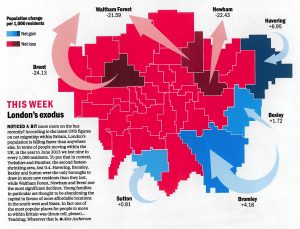
London’s Exodus


Time Out London, the venerable London free magazine, have spotted that everyone in London loves maps, and so have launched a regular London Mapped feature in their City Life section & blog. This week’s map is rather interesting and not one I’ve seen before. It shows ONS 2015 data on net migration between London’s boroughs and the rest of the UK – so it doesn’t include moves within London (which typically radiate outwards from Zone 1 to 6 as people age) or international migration (which tends to come straight in to Zones 2 to 3). Instead, it looks at the migration that happens when Londoners form families and need a bigger space than London can offer with their budget, or pensioners that yearn for the seaside, balanced against a steady, but often temporary, move to the universities in the capital. As people age, though, the quieter suburbs in London’s east and south-west still appeal, especially to the older generations.
The key statistic is an overall outflow (domestically) seen in London’s population. London in general is increasing in population, but this is mainly due to a combination of births and inwards international migration (and in particular, the high birth rate of international immigrants.) By removing these particular population sources flows, London suffers just under a 1% population decrease from 2014 to 2015 – a lesser reported statistic in between the headlines that London’s total population has recently hit an all-time high.
We like the simple, blocky style, which approximately retains the shape of the 32 boroughs (+ the City of London), so is a hybrid of a pure squares approach and a regular geographic data map. Bravely, the creator omits the River Thames, and also leaves out the names of most of the boroughs, just labelling (and arrowing) the top gainers and fallers. It’s a simple, but effective, way of showing an interesting demographic trend in across the metropolis. The map was created by Alex Ascherson, a data journalist at the Centre for Investigative Journalism.
In this week’s Tim Out London print edition, and in due course on the Time Out blog. The graphic is Copyright Time Out and Alex Ascherson.
